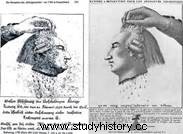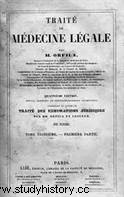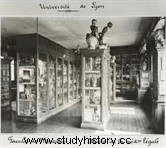 It all starts with the disappearance of an individual, either naturally or by fatality or extreme case an unnatural death . In the latter case, it is necessary to discover the author of this crime, to attribute the "good sentence" to him during a trial and it is therefore necessary to know the bodily injuries suffered by the deceased. “Forensic Medicine is the essential tool for the judicial investigation and the manifestation of the truth.
It all starts with the disappearance of an individual, either naturally or by fatality or extreme case an unnatural death . In the latter case, it is necessary to discover the author of this crime, to attribute the "good sentence" to him during a trial and it is therefore necessary to know the bodily injuries suffered by the deceased. “Forensic Medicine is the essential tool for the judicial investigation and the manifestation of the truth.
The appearance of the first legal texts
As early as 2100 BC. AD or around 1750 BC. J.-C. At that distant time, the dead were exposed in order to verify their identity, but autopsies as we know them today were not carried out, they simply removed the wounds and checked the affected organs. This required qualified doctors, which is how “the Hippocratic oath” appeared around the 4th century BC. J.-C. “I will abstain from all evil and all injustice. I will not give poison to anyone if asked, nor will I initiate such a suggestion”…
To determine the causes of fatal injuries, the function of medical examiner was born in the sixth century AD. J.-C., these men becoming true auxiliaries of justice:they inspected the skin, observed the orifices, and noted in particular the effects of the poison.
From the Middle Ages to the beginning of the Empire
The role of the medical expert is clarified by a law mentioning the fact that he has a responsibility, must give judgment and be an impartial arbiter, because in cases of justice, the magistrate must rely on medical evidence and seek the advice of a doctor in the event of blows, wounds, homicides, such as the report written in 1532 concerning the murder of the lord of Clanay "And first, in the head was found a wound on the right side which appears to have been made with a sword, plus another slash to the left side, plus another cut between the eye and the ear which was made with a penetrating dagger or mandocian to the temple, more, below the said blow, there are two blows made by a mandocian or a dagger descending towards the throat, the width of two fingers, and below these, there are has another similar in breadth and depth!
In Europe, Frederick II organized medical studies and issued an edict authorizing the dissection of human corpses in 1241. 130 years later, the pope gave the university the privilege Medicine of Montpellier to perform autopsies.
 Forensic medicine took on great importance in the 16th century:a Criminal Code was drafted between 1530 and 1532 by Charles fifth; Ambroise Paré wrote the first notions of forensic medicine in France, in his "Surgery books", notions understandable to non-doctors. It included all the explanations necessary to write a medical report, with supporting documents, analyses, habits and customs of the time (embalming methods, products used), using reports from family memoirs; the first medical examiner is Zacchias, personal physician of Pope Innocent X who summarizes his medical experiences in "Questions medico-legal" between 1621 and 1635; Vesalius, professor of anatomy in Bologna then Pisa, wrote books based on his experiences, with illustrated plates "On the functioning of the human body" and ended his career as imperial physician to Charles V.
Forensic medicine took on great importance in the 16th century:a Criminal Code was drafted between 1530 and 1532 by Charles fifth; Ambroise Paré wrote the first notions of forensic medicine in France, in his "Surgery books", notions understandable to non-doctors. It included all the explanations necessary to write a medical report, with supporting documents, analyses, habits and customs of the time (embalming methods, products used), using reports from family memoirs; the first medical examiner is Zacchias, personal physician of Pope Innocent X who summarizes his medical experiences in "Questions medico-legal" between 1621 and 1635; Vesalius, professor of anatomy in Bologna then Pisa, wrote books based on his experiences, with illustrated plates "On the functioning of the human body" and ended his career as imperial physician to Charles V.
Henri IV, before disappearing, orders the appointment of two surgeons in each city of great importance, in order to analyze the wounded, killed, mutilated and others. Around 1700, Pierre Dionis, doctor to Queen Marie Thérèse of Austria, professor of anatomy and surgery at the Jardin du Roi in Paris, recommended that autopsies be carried out within twenty-four hours after the death of the individual, a part to be sure that he is dead and so that the entourage does not lend bad intentions to the doctors as for their speed to prove the causes of the death. The autopsy must be performed at the place where the body was found.
Time goes on, the means change, improve, we preserve the bodies better in order to proceed with the exhumation in case, because if we do not find everything immediately the mortal causes, the body is opened, the skull is sawed off as in the case of the servant of Saint Nectaire in 1765, who died in an unexplained and rapid manner, whereas a week before he had just taken a gunshot in the knee ! New studies are carried out, we analyze drownings, asphyxiations.
After the Revolution, in the years 1794-1795, inventions appeared in large numbers:the microscope, radiology, toxicology, chairs of forensic medicine were established in each faculty of medicine…
Forensic medicine in recent centuries
It was an explosion of knowledge in forensic medicine:Haussmann had a morgue built (which was destroyed before the First World War and then newly established on the Quai de la Râpée in Paris, taking the name of Forensic Institute), with all the techniques necessary for the refrigeration for the conservation of the corpses, which until then were presented to the public, for three days, without conservation!
 In the 19th century, medical reports became more complete, more precise, clear and distinct, mentioning the rigidity of the corpse, decomposition, putrefaction, disease complications, hemorrhages, different skin colors thanks to progress and discoveries in blood analysis, infectious diseases, Louis Pasteur, Claude Bernard, Flemming... We are also starting to talk about individual behavior and the notions of psychology and psychiatry enter into criminal cases. Before, the "crazy" were judged like the rest of the population, the notion of "irresponsibility" appears as proven by the case of Antoine Léger in 1824:accused of murdering a little girl, he bleeds her, drinks her blood , eats his heart! He is sentenced to death, even if the lawyer invokes madness! His skull will be autopsied to detect brain neuroses leading to such acts of madness.
In the 19th century, medical reports became more complete, more precise, clear and distinct, mentioning the rigidity of the corpse, decomposition, putrefaction, disease complications, hemorrhages, different skin colors thanks to progress and discoveries in blood analysis, infectious diseases, Louis Pasteur, Claude Bernard, Flemming... We are also starting to talk about individual behavior and the notions of psychology and psychiatry enter into criminal cases. Before, the "crazy" were judged like the rest of the population, the notion of "irresponsibility" appears as proven by the case of Antoine Léger in 1824:accused of murdering a little girl, he bleeds her, drinks her blood , eats his heart! He is sentenced to death, even if the lawyer invokes madness! His skull will be autopsied to detect brain neuroses leading to such acts of madness.
In 1831, a “treaty on legal exhumations” appeared, countering the old beliefs that found this practice harmful to the body of the dead; and yet it turns out that it is very often important to exhume a corpse to verify the hypotheses of death which may be different:hence the scientific interest of carrying out deferred examinations! These are only requested by the judicial body. The authors of this treatise practiced "experimental" forensic medicine, that is to say, to see if the body is altered and to note the conservation after long-term burial. The exhumed body producing unbearable odors, it is enough to spread water added with lime chloride. After complete examination and dissection of the corpse, it appears that arsenic does not particularly delay the corruption of corpses (as was believed in the 16th century), is an excellent "mommifier", but its presence in a body does not say that there was poisoning.
Nowadays it is common practice to exhume bodies, redo analyzes in order to obtain new theses and new results concerning deaths not fully explained, such as this was the case for Charles XII of Sweden or for the Grand Duke of Tuscany!
The skeletons haven't finished talking!
Bibliography
- The secrets of the Great Crimes of History – Philippe Charlier. Vuibert, March 2012.
- A history of forensics and criminal identification. PUF, 2015.
